
Many US retailers are featuring shallower discounts while changing the frequency and mix of weekly advertisements, causing consumers to respond in a variety of ways across categories and items.
In the produce department, everyday low prices are becoming the prominent strategy at retail, according to a recent report from The Perishables Group.
The analyst claims that so far this year retailers have increased produce promotional prices (up 8.6 per cent) by more than twice as much as non-promotional prices (3.8 per cent).
“This rise in promotional prices indicates retailers are trying to keep everyday prices as competitive as possible,” the Perishables Group said.
“When everyday prices are low, it’s difficult to offer deep discounts, because the retailer doesn’t have the higher non-promoted prices to subsidise overall sales.”
The emphasis on low everyday prices is evident in promotional sales, with 22 of 33 fruit and vegetable categories experiencing declines in the percentage of volume purchased by consumers while on promotion.
The only category with a notable increase in promoted volume was cherries, which is a seasonal and high-priced product.
Consumers purchased staple categories, such as berries and potatoes, more at everyday prices while promoted volume declined by 5 per cent or more.
“Less promotional activity in the produce department isn’t necessarily a bad thing, as long as consumers keep purchasing from the department,” The Perishables Group said.
“Year-to-date, produce department dollar sales increased 4.6 per cent while volume remained fairly steady (-0.8 per cent), proving consumers are responsive to everyday low prices on fruits and vegetables.”
The Perishables Group says the dilemma facing the industry is how to predict long-term trends.
“If traditional retailers aren’t offering deep price reductions, are they at risk of losing shoppers to other retail formats?,” the agency asked.
“The challenge is to continue to modify the approach to stay in sync with consumers based on the unique conditions of each fresh department.”



